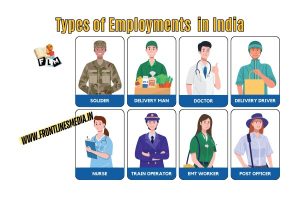The job market is growing exponentially, and thus employment terms are much needed by the employees than employers. Below is a list of top 30 employment terms widely used in India from salary structures to benefits and even laws. Now, knowing these terms also helps make decisions concerning the job, career growth, and rights as workers.
We will also show you how these terms play out for the employee and the employer.
1. Employment Contract
An employment contract is an agreement between an employer and an employee. A contract normally contains the conditions of the job, kind of work that a human should engage in, the amount to be paid, and working hours. Contracts help the employer know whether the expectations he has on the employee are mutual. The contract then turns out to be a guarantee paper for the employee and the company since the job roles are clarified.
2. Probation Period
Probation period is the time during which the performance of a new employee is checked. It’s almost like a “probationary period” when the company and the employees see if the job is right for them. During the period, the employees won’t be entitled to all the facilities they will get later; however, if they complete the period, they become permanent employees.
3. Notice Period
The duration by which an employee has to continue working in a company after one has tendered resignation before one can vacate is known as a notice period. It helps in giving the company a smooth passage besides giving the outgoing employee enough time to pass on his or her responsibilities. The notice periods differ in one company to another, but often, it is one month to three months.
4. Compensation Package
Scale of pay : It defines the division of salary of a person. It has many components such as basic salary, HRA, and so on. Flexible labor or high saving on income tax is experienced by the employee as well as the employer in case of good scale of pay. The value of knowing the scale of pay is important as it determines your salary after all deductions.
5. Provident Fund (PF)
Provident Fund (PF) This is a long-term savings scheme where the employer and the employee contribute every month from his salary. It is one of the retirement saving schemes for an individual employee. At the time of retirement, all the saved amount in PF with interest is released to him.
6. Gratuity
Gratuity is a large sum, paid to employees after spending some years (normally five years) in an organization. It is a sort of recognition for his/her service by staying long with the organization. Gratuity amount provides a sort of financial security to the worker when leaving the job .
7. Leave Policy
The leave policy indicates the number of days an employee can spend outside work for vacation, sickness, or any personal reasons. There are informal leaves, earning leaves as well as medical leaves. According to each company policy, this knowledge would help the employees to utilize the entitlements to perfection.
8. Employee Stock Options (ESOPs)
Employee Stock Options, or ESOPs, are a company’s shares given to its employees. It allows employees to be co-owner of the company. When the value of the company goes high, then the employees also gain by this experience. Most of the times, these ESOPs are provided to start-ups and technology companies.
9. Payroll
Payroll is the total amount of money a company has to pay to all the employees. This sum also includes all the taxes on an employee, PF contribution, and other deductions. Payroll management is important for two sets of people: the employees who need timely payment for their services, and the employer who needs to fulfill the legal obligations.
10. Labor Law
Labor laws are regulations that protect the rights of the employees as well as regulate the employer’s responsibilities. They vary from working hours and wages up to the safety at work place and lots of other issues. In India, numerous such law, including Factories Act and Minimum Wages Act, exist solely to protect the workers.
11. Skill Development
The employees acquire their skills by skill development programs or even new skills they pick at work. Companies should provide training programs or sponsor courses for employee growth. Thus, with an employee who upskills, then it works to his or her advantage as well as his or her employer’s advantage since he or she will be more effective at work.
12. Job Description (JD)
A job description defines the roles, duties, and expertise required in any given position. It therefore helps employers and employees understand what is expected. Proper job description will help in performance review as well as in recruiting the right candidate for the available positions.
13. Full-Time Employment
Full-time Employment is that which requires a fixed schedule, normally 40 hours a week. Staff under fulltime employment get benefits like health insurance and PF, and they receive pay leaves. This is the most common employment.

14. Part-Time Employment
The part-time job is an employment position that requires one to work fewer hours than a full-time employee. Part-time jobs are relatively flexible; however, they might not enjoy all of the benefits found in full-time employment such as health insurance and paid leave although many companies offer some benefits to part-time employees.
15. Internship
An internship is a part time work through which one could gain practical experience in any field. Most students and graduates have been attracted to internships for the need to learn the ropes before venturing into the job market.
16. Freelancing
Freelancing also refers to work independent for several clients rather than the company being tied to a single employer. Freelancers are paid per project completion and would generally derive a significant amount of flexibility in scheduling. However, the freelancers usually do not enjoy benefits such as health insurance or PF.
17. Termination
Termination means terminated from work place or from work. This takes place when an employee quits or resigns from his or her job or gets fired by the company. Termination happens due to different causes like poor performance of the employee or downsizing.
18. Retrenchment
Retrenchment simply refers to the downsizing of employees. This can be attributed to either economic-related factors or company restructuring. As such, it does not have a direct association with poor performance on their part. As a matter of fact, retrenchment is often due to the cost-cutting needs of the firm.
19. Compensation Package
A compensation package, for instance, is the total income an employee receives in his or her compensation, which takes in a form that ranges from basic pay, bonus, and other fringe benefits to health insurance contributions towards retirement, and many more. Therefore, it goes beyond the payment of basic pay and forms an important part of the attraction and retention mechanism for the right talent.
20. Work from Home (WFH)
Work from Home (WFH) is one of the flexible styles of work which has allowed the employees to obtain their work outside of the office rather than coming to the office. This WFH became trendy during the COVID-19 outbreak and becomes a choice for a lot of employees now.
21. Performance Appraisal
A performance review is the official rating of how well an employee performs a job. This is usually carried out on an annual basis and helps make decisions regarding increases in salary, promotion, or areas where an employee needs to improve.
22. Team Building
Team building is the activities that help enhance teamwork and coordination in the workforce. Good team building exercises lead to better communication, relation, and productivity levels.
23. Employee Engagement
Employee engagement may be described as the bond workers share with an organization that has a given mission. The engaged workers are more effective, spend a lot of time within the organization, and positively influence the organizational culture.
24. Onboarding
Onboarding is the process of initiating new employees into an organization. In this, training, getting to know the colleagues, and sight seeing of company policies generally tend to be involved. A good onboarding process helps a new employee adjust well in the role quickly.
25. Exit Interview
An exit interview is the process of communication between the organization and the leaving employee. This ensures why an employee is leaving and also does provide necessary feedback, which could be improved in the company.

26. Human Resources (HR)
The Human Resources engages every activity that concerns the employees: from hiring to payroll to grievances. HR ensures that there is a healthy environment in which to work.
27. Workplace Diversity
Workplace diversity is the inclusion of various employees belonging to different genders, races, ages, and different types of ability. A diverse workplace brings about different kinds of ideas because of perspectives which may lead to higher innovation and creativity.
28. Contractual Employment
Contractual employment involves a period of employment that is contracted for. Beyond this period, there is no guarantee that the employee will continue unless a repetition or renewal is indicated. Such a form of employment is very common in IT, construction, and entertainment sectors.
29. Job Rotation
Job rotation is an activity where an organization transfers employees from one job or department to another. It is one of the best ways for training employee on new skills and making their work life interesting. Companies consider this as the right time to identify multi-skilled employees.
30. Work-Life Balance
It gives work-life balance, meaning an employee can balance the duties of his job with his personal life. This balance ensures that workers neither feel overpowered by their job nor oppressive at home as they find some time to relax and recharge.

What is CTC:
CTC stands for “Cost to Company,” a word that perhaps goes hand in hand with jobs in India as much as or more than any term ever has. It indicates the whole expense an employer spends during the course of a year when hiring a worker/employee.
Take-home pay and CTC are not the same thing, CTC is not the same as take-home pay because it consists of several elements that add to the employer’s overall costs.
1. Basic Salary: This is the basic component of CTC and probably the most frequently used term when it comes to jobs in India. It usually forms the basis of 40-50% of the total CTC.
2. House Rent Allowance: A term used in relation to accommodation and rental support for employees, particularly in cities where living costs are expensive.
3. Provident Fund (PF): Another important term that is associated with jobs, this is actually a Government-mandated saving scheme in which both parties employer and employee contribute an equal percentage.
This is the difference between CTC and net salary for both employees and employers. The difference should be known clearly to employees so that proper management of expectations and finances may be achieved. The perception of CTC in relation to total costs incurred for hiring and maintaining worker satisfaction is a point that has to be understood clearly by the employer.

Salary/Wage Components: Important Terms Relating to Jobs in India
The salary in India is comprised of several elements. Knowing these terms related to jobs is essential for both employees and employers to understand how earnings and costs are distributed.
1. Base Salary
Basic salary is usually the largest component of a salary and also forms the base level. The basic salary is a fixed amount and many other items in the salary are calculated by considering the basic salary.
2. Dearness Allowance (DA)
A term very frequently used in jobs, primarily in the public sector. Dearness Allowance is an allowance extended to employees in view of raising inflation.
3. House Rent Allowance HRA
An allowance related to all living expense, helps employees pay for their respective housing needs. These allowances become very important in cities where the rentals are high.
4. Bonus
The bonus is another term related to jobs that applies to both the private and public sectors. A bonus is the payment based on performance or a statutory bonus under the Payment of Bonus Act or a festival bonus like dasara bonus, deepavali bonus, sankranti bonus.
5. Gratuity
Gratuity is a word that follows retirement benefit and is paid to the employee if he/she has served in an organisation for five or more years.
Impact of CTC on Employees
Understanding of CTC is crucial to the employees, as they would get clear picture about how much they would take home, having taxes and insurance deducted among other things. Employees need to get a clear picture of their CTC in order to understand how much they take home, after all the fluctuations in their income.

Example:
If the employee’s CTC is at ₹ 6,00,000, then this classification will be:
Gross Salary: ₹3,00,000
HRA: ₹1,20,000
Travel Allowance: ₹30,000
Medical Reimbursement: ₹15,000
Bonus: ₹30,000
Retirement Benefits: ₹60,000
Insurance: ₹45,000
How Salary Components Influence Take-Home Pay
Let’s consider sample deductions to understand how salary elements affect take-home pay. Generally, people’s common deductions include income tax, EPF, and professional tax.
For example:
For a person whose monthly gross salary is ₹50,000, the calculation can be as follows:
Income Tax: ₹5,000
EPF: ₹2,500
Professional Tax: ₹200
Calculate take-home salary:
Gross Salary: ₹50,000
Deductions: ₹7,700 (₹5,000 + ₹2,500 + ₹200)
Net Take-Home Salary: ₹50,000 – ₹7,700 = ₹42,300
Conclusion
These are the top 30 employment terms to understand employment so that both employees and employers may contribute to a fair, transparent, and productive work environment. Enter the job market, shift your jobs, or just curious about how employment works in India? Let this guide get you started with the basics in simple terms. Keep yourself informed, aware of your rights, and make the right career choices.




